Psychology Essay: Research Methods, Ethics, Validity, and Deception
VerifiedAdded on 2022/10/15
|10
|2794
|12
Essay
AI Summary
This essay addresses four key areas in psychological research. Firstly, it discusses the scientific method's role in answering questions and evaluating treatments, emphasizing its advantages over non-scientific approaches and illustrating this with a study on obesity and screen media exposure. Secondly, it examines the randomized controlled trial (RCT) as the best design for intervention studies, providing a hypothetical RCT study example on nutritional therapy for diabetes management, detailing its design, participants, and data analysis. Thirdly, the essay explores reliability and validity in psychological measurements, explaining their importance in ensuring credible data, discussing different types of validity and reliability, and providing examples of their application in psychological assessments, such as those used for dementia patients. Finally, it addresses the ethics of deception in psychological research, arguing against its use based on ethical principles, discussing the Milgram experiment as an example, and highlighting the conflicts between deception and informed consent, and the ethical responsibilities of researchers.
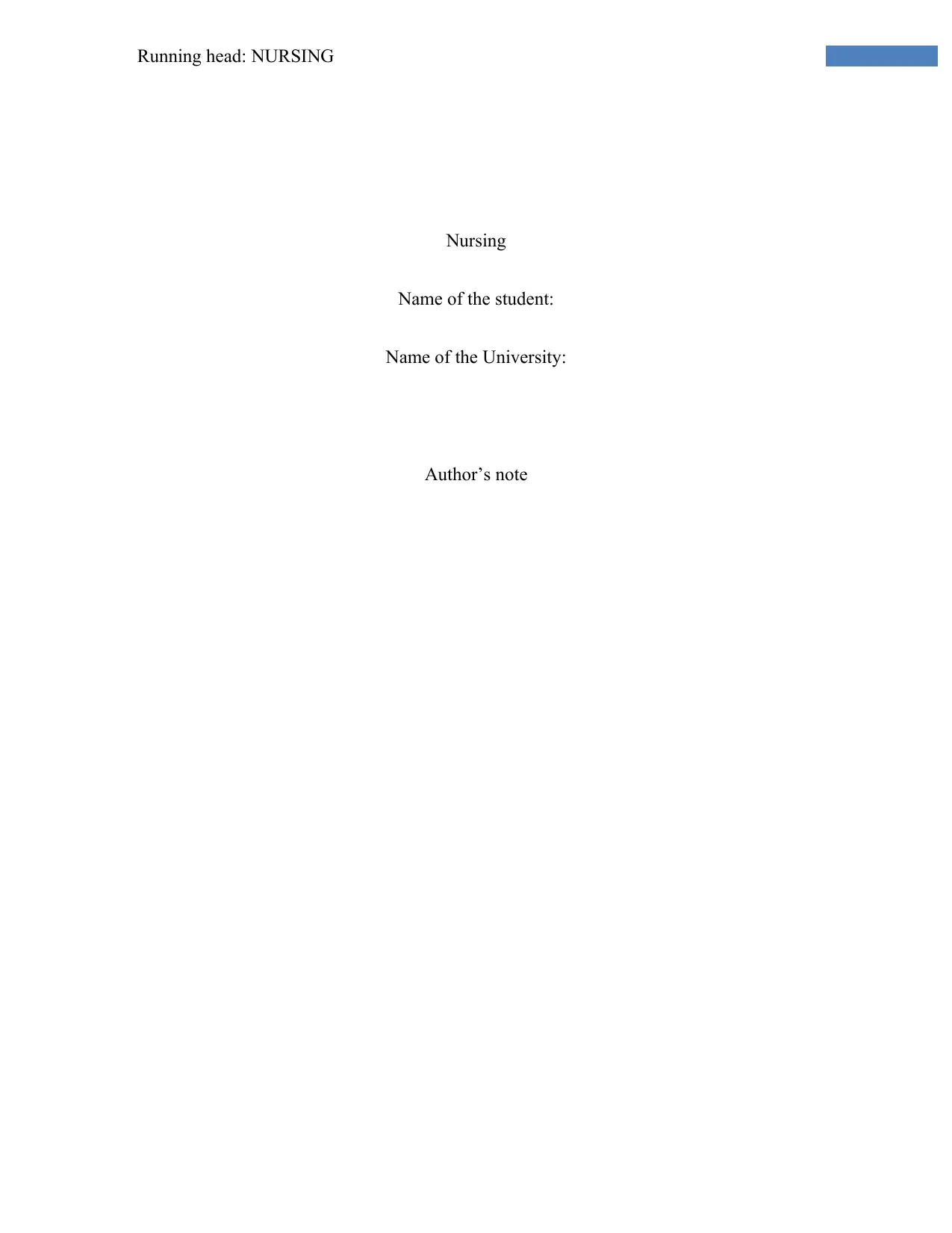
Running head: NURSING
Nursing
Name of the student:
Name of the University:
Author’s note
Nursing
Name of the student:
Name of the University:
Author’s note
Paraphrase This Document
Need a fresh take? Get an instant paraphrase of this document with our AI Paraphraser
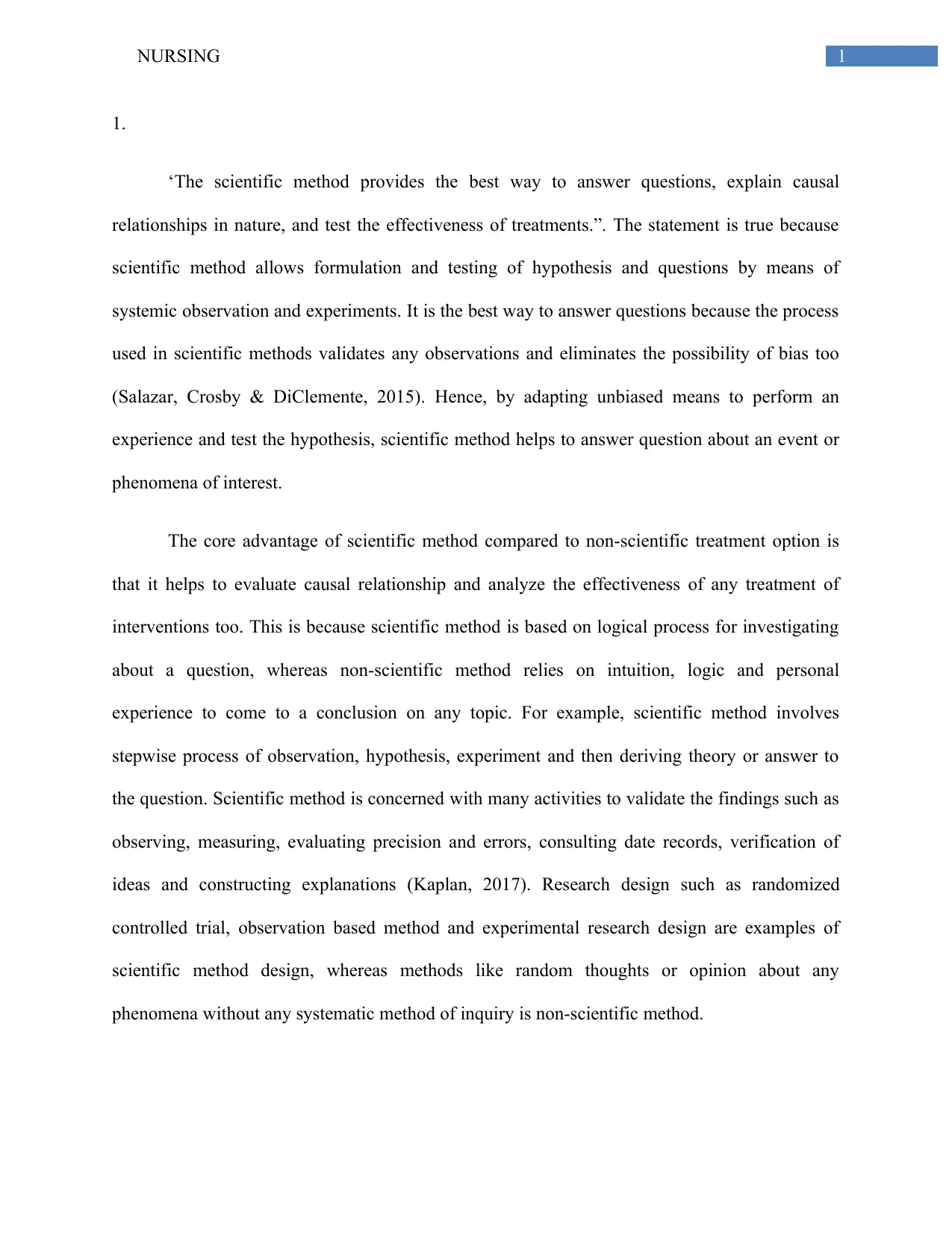
1NURSING
1.
‘The scientific method provides the best way to answer questions, explain causal
relationships in nature, and test the effectiveness of treatments.”. The statement is true because
scientific method allows formulation and testing of hypothesis and questions by means of
systemic observation and experiments. It is the best way to answer questions because the process
used in scientific methods validates any observations and eliminates the possibility of bias too
(Salazar, Crosby & DiClemente, 2015). Hence, by adapting unbiased means to perform an
experience and test the hypothesis, scientific method helps to answer question about an event or
phenomena of interest.
The core advantage of scientific method compared to non-scientific treatment option is
that it helps to evaluate causal relationship and analyze the effectiveness of any treatment of
interventions too. This is because scientific method is based on logical process for investigating
about a question, whereas non-scientific method relies on intuition, logic and personal
experience to come to a conclusion on any topic. For example, scientific method involves
stepwise process of observation, hypothesis, experiment and then deriving theory or answer to
the question. Scientific method is concerned with many activities to validate the findings such as
observing, measuring, evaluating precision and errors, consulting date records, verification of
ideas and constructing explanations (Kaplan, 2017). Research design such as randomized
controlled trial, observation based method and experimental research design are examples of
scientific method design, whereas methods like random thoughts or opinion about any
phenomena without any systematic method of inquiry is non-scientific method.
1.
‘The scientific method provides the best way to answer questions, explain causal
relationships in nature, and test the effectiveness of treatments.”. The statement is true because
scientific method allows formulation and testing of hypothesis and questions by means of
systemic observation and experiments. It is the best way to answer questions because the process
used in scientific methods validates any observations and eliminates the possibility of bias too
(Salazar, Crosby & DiClemente, 2015). Hence, by adapting unbiased means to perform an
experience and test the hypothesis, scientific method helps to answer question about an event or
phenomena of interest.
The core advantage of scientific method compared to non-scientific treatment option is
that it helps to evaluate causal relationship and analyze the effectiveness of any treatment of
interventions too. This is because scientific method is based on logical process for investigating
about a question, whereas non-scientific method relies on intuition, logic and personal
experience to come to a conclusion on any topic. For example, scientific method involves
stepwise process of observation, hypothesis, experiment and then deriving theory or answer to
the question. Scientific method is concerned with many activities to validate the findings such as
observing, measuring, evaluating precision and errors, consulting date records, verification of
ideas and constructing explanations (Kaplan, 2017). Research design such as randomized
controlled trial, observation based method and experimental research design are examples of
scientific method design, whereas methods like random thoughts or opinion about any
phenomena without any systematic method of inquiry is non-scientific method.
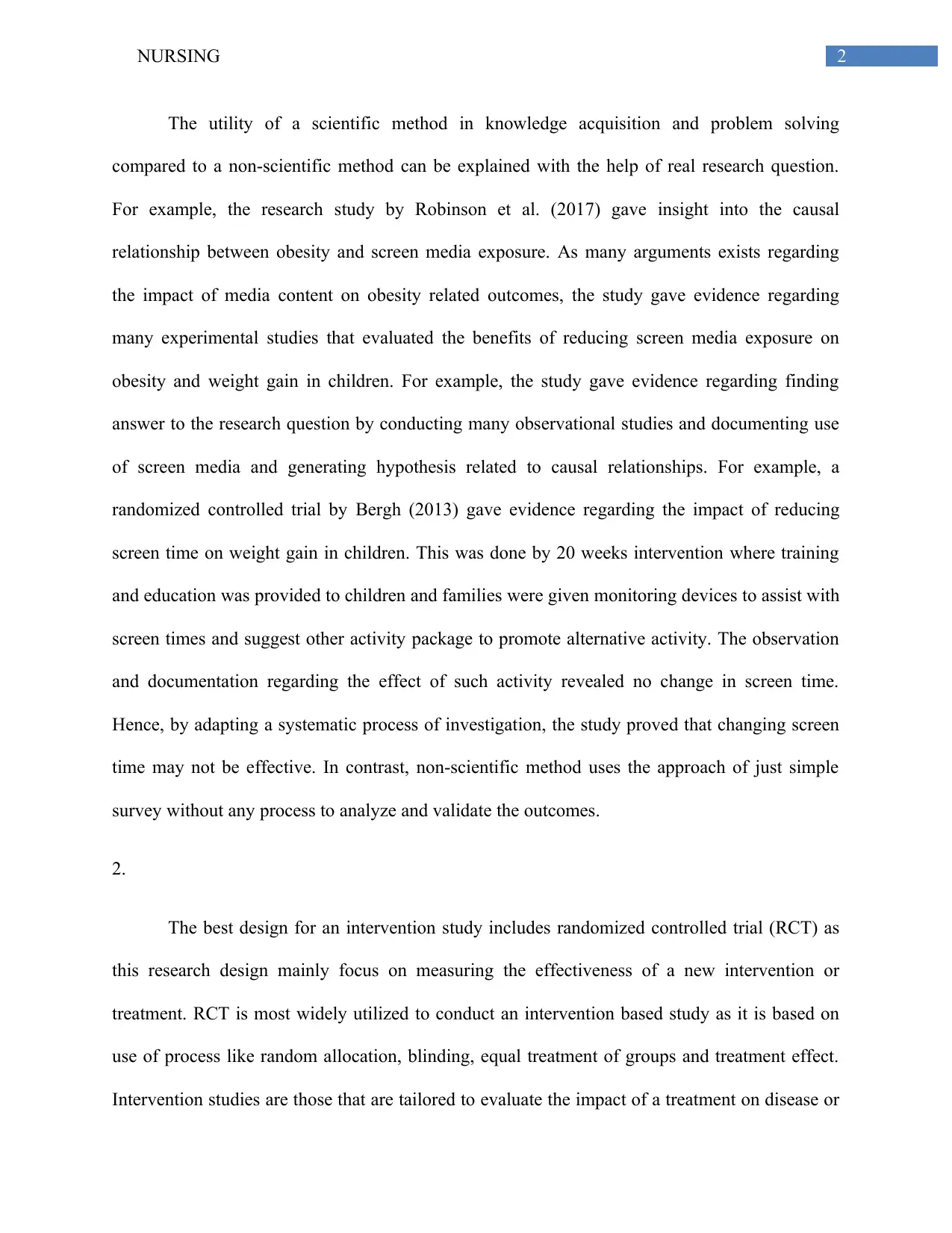
2NURSING
The utility of a scientific method in knowledge acquisition and problem solving
compared to a non-scientific method can be explained with the help of real research question.
For example, the research study by Robinson et al. (2017) gave insight into the causal
relationship between obesity and screen media exposure. As many arguments exists regarding
the impact of media content on obesity related outcomes, the study gave evidence regarding
many experimental studies that evaluated the benefits of reducing screen media exposure on
obesity and weight gain in children. For example, the study gave evidence regarding finding
answer to the research question by conducting many observational studies and documenting use
of screen media and generating hypothesis related to causal relationships. For example, a
randomized controlled trial by Bergh (2013) gave evidence regarding the impact of reducing
screen time on weight gain in children. This was done by 20 weeks intervention where training
and education was provided to children and families were given monitoring devices to assist with
screen times and suggest other activity package to promote alternative activity. The observation
and documentation regarding the effect of such activity revealed no change in screen time.
Hence, by adapting a systematic process of investigation, the study proved that changing screen
time may not be effective. In contrast, non-scientific method uses the approach of just simple
survey without any process to analyze and validate the outcomes.
2.
The best design for an intervention study includes randomized controlled trial (RCT) as
this research design mainly focus on measuring the effectiveness of a new intervention or
treatment. RCT is most widely utilized to conduct an intervention based study as it is based on
use of process like random allocation, blinding, equal treatment of groups and treatment effect.
Intervention studies are those that are tailored to evaluate the impact of a treatment on disease or
The utility of a scientific method in knowledge acquisition and problem solving
compared to a non-scientific method can be explained with the help of real research question.
For example, the research study by Robinson et al. (2017) gave insight into the causal
relationship between obesity and screen media exposure. As many arguments exists regarding
the impact of media content on obesity related outcomes, the study gave evidence regarding
many experimental studies that evaluated the benefits of reducing screen media exposure on
obesity and weight gain in children. For example, the study gave evidence regarding finding
answer to the research question by conducting many observational studies and documenting use
of screen media and generating hypothesis related to causal relationships. For example, a
randomized controlled trial by Bergh (2013) gave evidence regarding the impact of reducing
screen time on weight gain in children. This was done by 20 weeks intervention where training
and education was provided to children and families were given monitoring devices to assist with
screen times and suggest other activity package to promote alternative activity. The observation
and documentation regarding the effect of such activity revealed no change in screen time.
Hence, by adapting a systematic process of investigation, the study proved that changing screen
time may not be effective. In contrast, non-scientific method uses the approach of just simple
survey without any process to analyze and validate the outcomes.
2.
The best design for an intervention study includes randomized controlled trial (RCT) as
this research design mainly focus on measuring the effectiveness of a new intervention or
treatment. RCT is most widely utilized to conduct an intervention based study as it is based on
use of process like random allocation, blinding, equal treatment of groups and treatment effect.
Intervention studies are those that are tailored to evaluate the impact of a treatment on disease or
⊘ This is a preview!⊘
Do you want full access?
Subscribe today to unlock all pages.

Trusted by 1+ million students worldwide
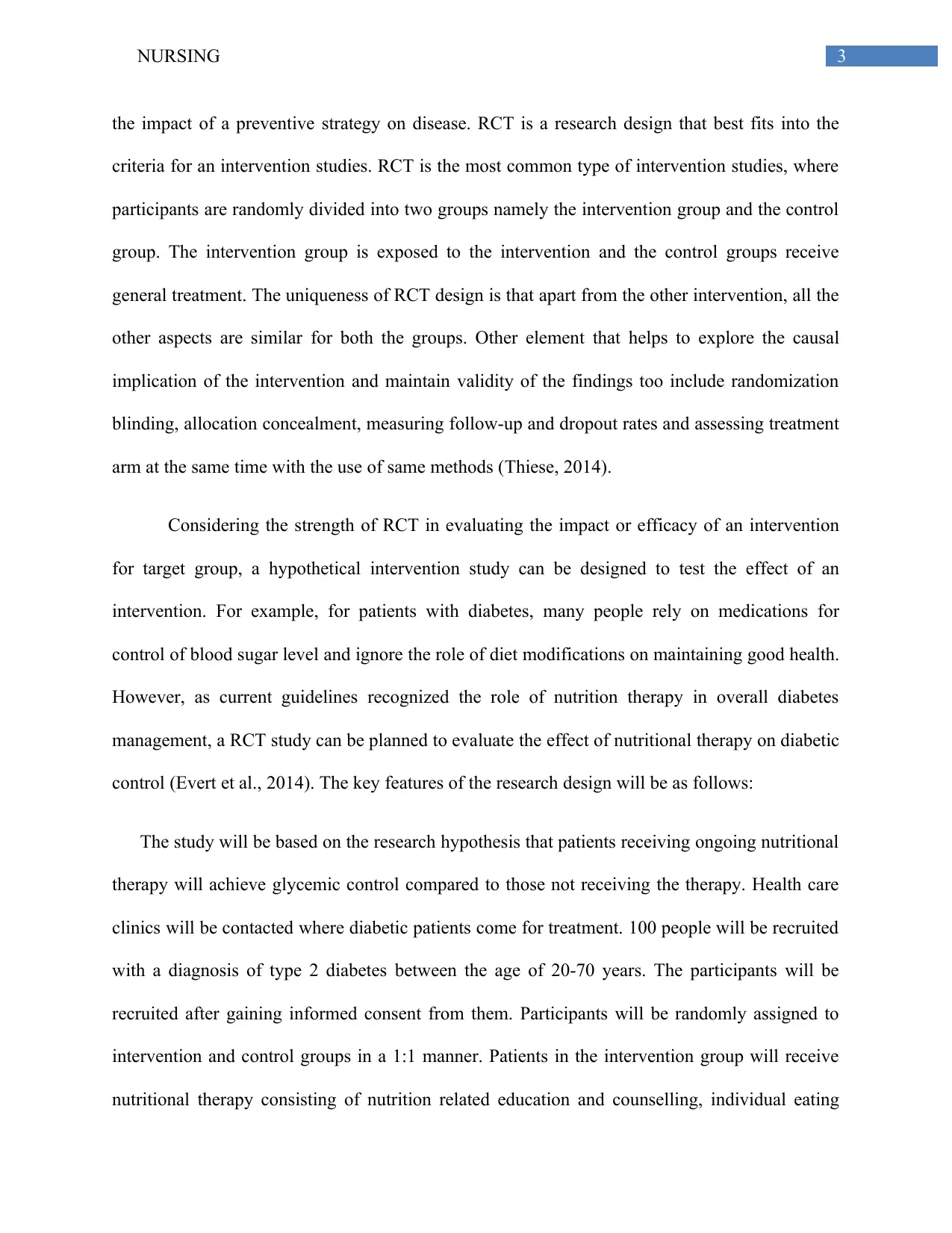
3NURSING
the impact of a preventive strategy on disease. RCT is a research design that best fits into the
criteria for an intervention studies. RCT is the most common type of intervention studies, where
participants are randomly divided into two groups namely the intervention group and the control
group. The intervention group is exposed to the intervention and the control groups receive
general treatment. The uniqueness of RCT design is that apart from the other intervention, all the
other aspects are similar for both the groups. Other element that helps to explore the causal
implication of the intervention and maintain validity of the findings too include randomization
blinding, allocation concealment, measuring follow-up and dropout rates and assessing treatment
arm at the same time with the use of same methods (Thiese, 2014).
Considering the strength of RCT in evaluating the impact or efficacy of an intervention
for target group, a hypothetical intervention study can be designed to test the effect of an
intervention. For example, for patients with diabetes, many people rely on medications for
control of blood sugar level and ignore the role of diet modifications on maintaining good health.
However, as current guidelines recognized the role of nutrition therapy in overall diabetes
management, a RCT study can be planned to evaluate the effect of nutritional therapy on diabetic
control (Evert et al., 2014). The key features of the research design will be as follows:
The study will be based on the research hypothesis that patients receiving ongoing nutritional
therapy will achieve glycemic control compared to those not receiving the therapy. Health care
clinics will be contacted where diabetic patients come for treatment. 100 people will be recruited
with a diagnosis of type 2 diabetes between the age of 20-70 years. The participants will be
recruited after gaining informed consent from them. Participants will be randomly assigned to
intervention and control groups in a 1:1 manner. Patients in the intervention group will receive
nutritional therapy consisting of nutrition related education and counselling, individual eating
the impact of a preventive strategy on disease. RCT is a research design that best fits into the
criteria for an intervention studies. RCT is the most common type of intervention studies, where
participants are randomly divided into two groups namely the intervention group and the control
group. The intervention group is exposed to the intervention and the control groups receive
general treatment. The uniqueness of RCT design is that apart from the other intervention, all the
other aspects are similar for both the groups. Other element that helps to explore the causal
implication of the intervention and maintain validity of the findings too include randomization
blinding, allocation concealment, measuring follow-up and dropout rates and assessing treatment
arm at the same time with the use of same methods (Thiese, 2014).
Considering the strength of RCT in evaluating the impact or efficacy of an intervention
for target group, a hypothetical intervention study can be designed to test the effect of an
intervention. For example, for patients with diabetes, many people rely on medications for
control of blood sugar level and ignore the role of diet modifications on maintaining good health.
However, as current guidelines recognized the role of nutrition therapy in overall diabetes
management, a RCT study can be planned to evaluate the effect of nutritional therapy on diabetic
control (Evert et al., 2014). The key features of the research design will be as follows:
The study will be based on the research hypothesis that patients receiving ongoing nutritional
therapy will achieve glycemic control compared to those not receiving the therapy. Health care
clinics will be contacted where diabetic patients come for treatment. 100 people will be recruited
with a diagnosis of type 2 diabetes between the age of 20-70 years. The participants will be
recruited after gaining informed consent from them. Participants will be randomly assigned to
intervention and control groups in a 1:1 manner. Patients in the intervention group will receive
nutritional therapy consisting of nutrition related education and counselling, individual eating
Paraphrase This Document
Need a fresh take? Get an instant paraphrase of this document with our AI Paraphraser
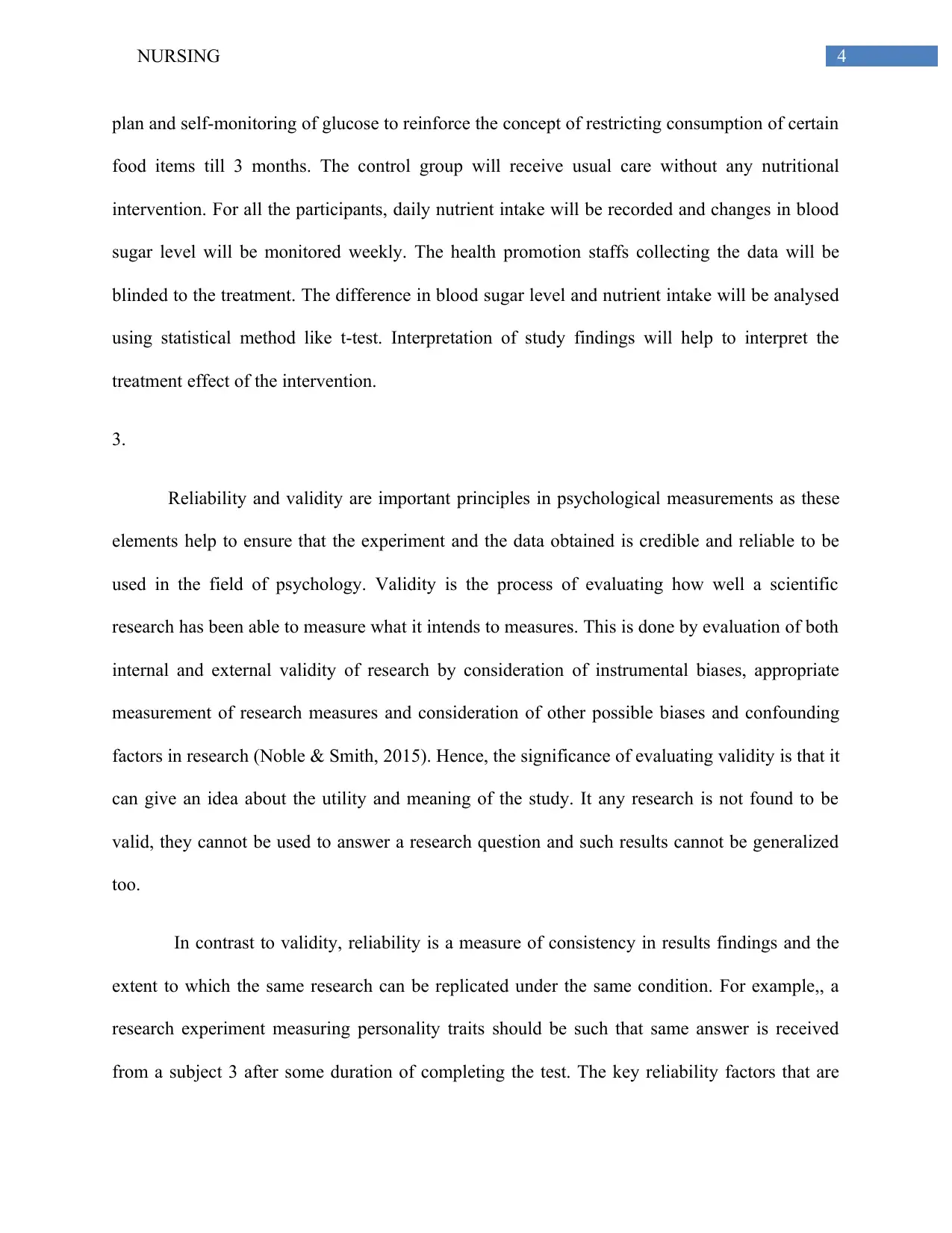
4NURSING
plan and self-monitoring of glucose to reinforce the concept of restricting consumption of certain
food items till 3 months. The control group will receive usual care without any nutritional
intervention. For all the participants, daily nutrient intake will be recorded and changes in blood
sugar level will be monitored weekly. The health promotion staffs collecting the data will be
blinded to the treatment. The difference in blood sugar level and nutrient intake will be analysed
using statistical method like t-test. Interpretation of study findings will help to interpret the
treatment effect of the intervention.
3.
Reliability and validity are important principles in psychological measurements as these
elements help to ensure that the experiment and the data obtained is credible and reliable to be
used in the field of psychology. Validity is the process of evaluating how well a scientific
research has been able to measure what it intends to measures. This is done by evaluation of both
internal and external validity of research by consideration of instrumental biases, appropriate
measurement of research measures and consideration of other possible biases and confounding
factors in research (Noble & Smith, 2015). Hence, the significance of evaluating validity is that it
can give an idea about the utility and meaning of the study. It any research is not found to be
valid, they cannot be used to answer a research question and such results cannot be generalized
too.
In contrast to validity, reliability is a measure of consistency in results findings and the
extent to which the same research can be replicated under the same condition. For example,, a
research experiment measuring personality traits should be such that same answer is received
from a subject 3 after some duration of completing the test. The key reliability factors that are
plan and self-monitoring of glucose to reinforce the concept of restricting consumption of certain
food items till 3 months. The control group will receive usual care without any nutritional
intervention. For all the participants, daily nutrient intake will be recorded and changes in blood
sugar level will be monitored weekly. The health promotion staffs collecting the data will be
blinded to the treatment. The difference in blood sugar level and nutrient intake will be analysed
using statistical method like t-test. Interpretation of study findings will help to interpret the
treatment effect of the intervention.
3.
Reliability and validity are important principles in psychological measurements as these
elements help to ensure that the experiment and the data obtained is credible and reliable to be
used in the field of psychology. Validity is the process of evaluating how well a scientific
research has been able to measure what it intends to measures. This is done by evaluation of both
internal and external validity of research by consideration of instrumental biases, appropriate
measurement of research measures and consideration of other possible biases and confounding
factors in research (Noble & Smith, 2015). Hence, the significance of evaluating validity is that it
can give an idea about the utility and meaning of the study. It any research is not found to be
valid, they cannot be used to answer a research question and such results cannot be generalized
too.
In contrast to validity, reliability is a measure of consistency in results findings and the
extent to which the same research can be replicated under the same condition. For example,, a
research experiment measuring personality traits should be such that same answer is received
from a subject 3 after some duration of completing the test. The key reliability factors that are
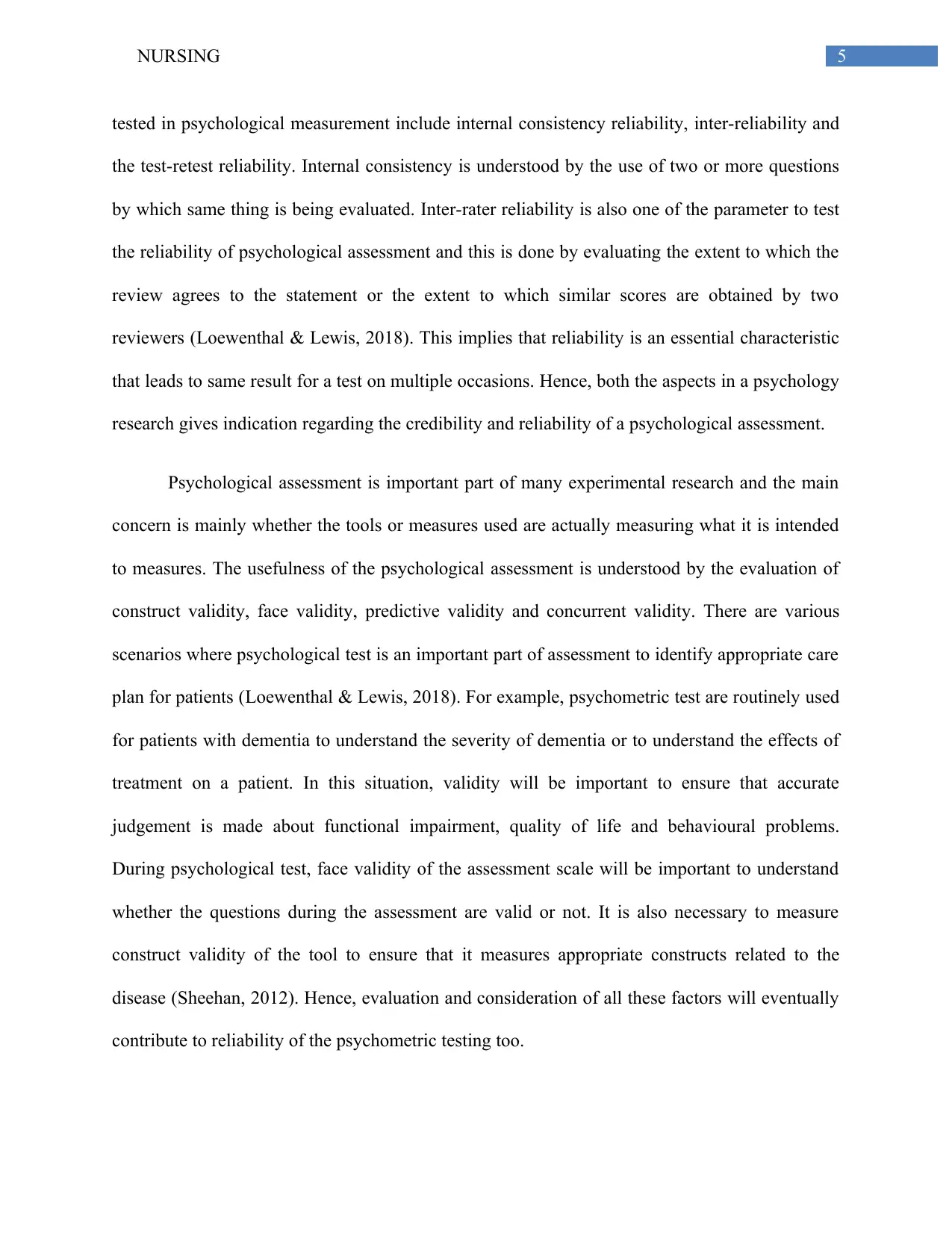
5NURSING
tested in psychological measurement include internal consistency reliability, inter-reliability and
the test-retest reliability. Internal consistency is understood by the use of two or more questions
by which same thing is being evaluated. Inter-rater reliability is also one of the parameter to test
the reliability of psychological assessment and this is done by evaluating the extent to which the
review agrees to the statement or the extent to which similar scores are obtained by two
reviewers (Loewenthal & Lewis, 2018). This implies that reliability is an essential characteristic
that leads to same result for a test on multiple occasions. Hence, both the aspects in a psychology
research gives indication regarding the credibility and reliability of a psychological assessment.
Psychological assessment is important part of many experimental research and the main
concern is mainly whether the tools or measures used are actually measuring what it is intended
to measures. The usefulness of the psychological assessment is understood by the evaluation of
construct validity, face validity, predictive validity and concurrent validity. There are various
scenarios where psychological test is an important part of assessment to identify appropriate care
plan for patients (Loewenthal & Lewis, 2018). For example, psychometric test are routinely used
for patients with dementia to understand the severity of dementia or to understand the effects of
treatment on a patient. In this situation, validity will be important to ensure that accurate
judgement is made about functional impairment, quality of life and behavioural problems.
During psychological test, face validity of the assessment scale will be important to understand
whether the questions during the assessment are valid or not. It is also necessary to measure
construct validity of the tool to ensure that it measures appropriate constructs related to the
disease (Sheehan, 2012). Hence, evaluation and consideration of all these factors will eventually
contribute to reliability of the psychometric testing too.
tested in psychological measurement include internal consistency reliability, inter-reliability and
the test-retest reliability. Internal consistency is understood by the use of two or more questions
by which same thing is being evaluated. Inter-rater reliability is also one of the parameter to test
the reliability of psychological assessment and this is done by evaluating the extent to which the
review agrees to the statement or the extent to which similar scores are obtained by two
reviewers (Loewenthal & Lewis, 2018). This implies that reliability is an essential characteristic
that leads to same result for a test on multiple occasions. Hence, both the aspects in a psychology
research gives indication regarding the credibility and reliability of a psychological assessment.
Psychological assessment is important part of many experimental research and the main
concern is mainly whether the tools or measures used are actually measuring what it is intended
to measures. The usefulness of the psychological assessment is understood by the evaluation of
construct validity, face validity, predictive validity and concurrent validity. There are various
scenarios where psychological test is an important part of assessment to identify appropriate care
plan for patients (Loewenthal & Lewis, 2018). For example, psychometric test are routinely used
for patients with dementia to understand the severity of dementia or to understand the effects of
treatment on a patient. In this situation, validity will be important to ensure that accurate
judgement is made about functional impairment, quality of life and behavioural problems.
During psychological test, face validity of the assessment scale will be important to understand
whether the questions during the assessment are valid or not. It is also necessary to measure
construct validity of the tool to ensure that it measures appropriate constructs related to the
disease (Sheehan, 2012). Hence, evaluation and consideration of all these factors will eventually
contribute to reliability of the psychometric testing too.
⊘ This is a preview!⊘
Do you want full access?
Subscribe today to unlock all pages.

Trusted by 1+ million students worldwide
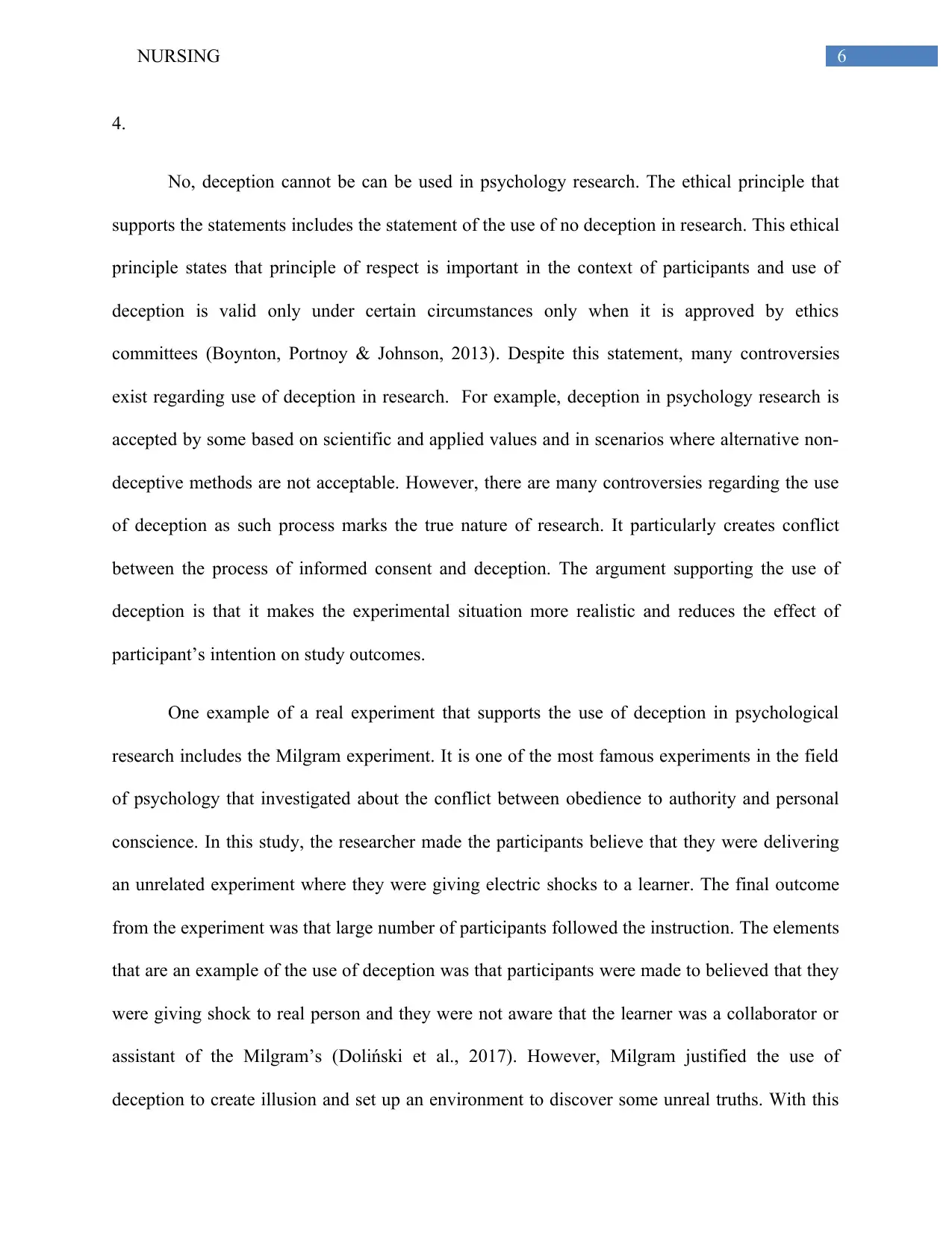
6NURSING
4.
No, deception cannot be can be used in psychology research. The ethical principle that
supports the statements includes the statement of the use of no deception in research. This ethical
principle states that principle of respect is important in the context of participants and use of
deception is valid only under certain circumstances only when it is approved by ethics
committees (Boynton, Portnoy & Johnson, 2013). Despite this statement, many controversies
exist regarding use of deception in research. For example, deception in psychology research is
accepted by some based on scientific and applied values and in scenarios where alternative non-
deceptive methods are not acceptable. However, there are many controversies regarding the use
of deception as such process marks the true nature of research. It particularly creates conflict
between the process of informed consent and deception. The argument supporting the use of
deception is that it makes the experimental situation more realistic and reduces the effect of
participant’s intention on study outcomes.
One example of a real experiment that supports the use of deception in psychological
research includes the Milgram experiment. It is one of the most famous experiments in the field
of psychology that investigated about the conflict between obedience to authority and personal
conscience. In this study, the researcher made the participants believe that they were delivering
an unrelated experiment where they were giving electric shocks to a learner. The final outcome
from the experiment was that large number of participants followed the instruction. The elements
that are an example of the use of deception was that participants were made to believed that they
were giving shock to real person and they were not aware that the learner was a collaborator or
assistant of the Milgram’s (Doliński et al., 2017). However, Milgram justified the use of
deception to create illusion and set up an environment to discover some unreal truths. With this
4.
No, deception cannot be can be used in psychology research. The ethical principle that
supports the statements includes the statement of the use of no deception in research. This ethical
principle states that principle of respect is important in the context of participants and use of
deception is valid only under certain circumstances only when it is approved by ethics
committees (Boynton, Portnoy & Johnson, 2013). Despite this statement, many controversies
exist regarding use of deception in research. For example, deception in psychology research is
accepted by some based on scientific and applied values and in scenarios where alternative non-
deceptive methods are not acceptable. However, there are many controversies regarding the use
of deception as such process marks the true nature of research. It particularly creates conflict
between the process of informed consent and deception. The argument supporting the use of
deception is that it makes the experimental situation more realistic and reduces the effect of
participant’s intention on study outcomes.
One example of a real experiment that supports the use of deception in psychological
research includes the Milgram experiment. It is one of the most famous experiments in the field
of psychology that investigated about the conflict between obedience to authority and personal
conscience. In this study, the researcher made the participants believe that they were delivering
an unrelated experiment where they were giving electric shocks to a learner. The final outcome
from the experiment was that large number of participants followed the instruction. The elements
that are an example of the use of deception was that participants were made to believed that they
were giving shock to real person and they were not aware that the learner was a collaborator or
assistant of the Milgram’s (Doliński et al., 2017). However, Milgram justified the use of
deception to create illusion and set up an environment to discover some unreal truths. With this
Paraphrase This Document
Need a fresh take? Get an instant paraphrase of this document with our AI Paraphraser
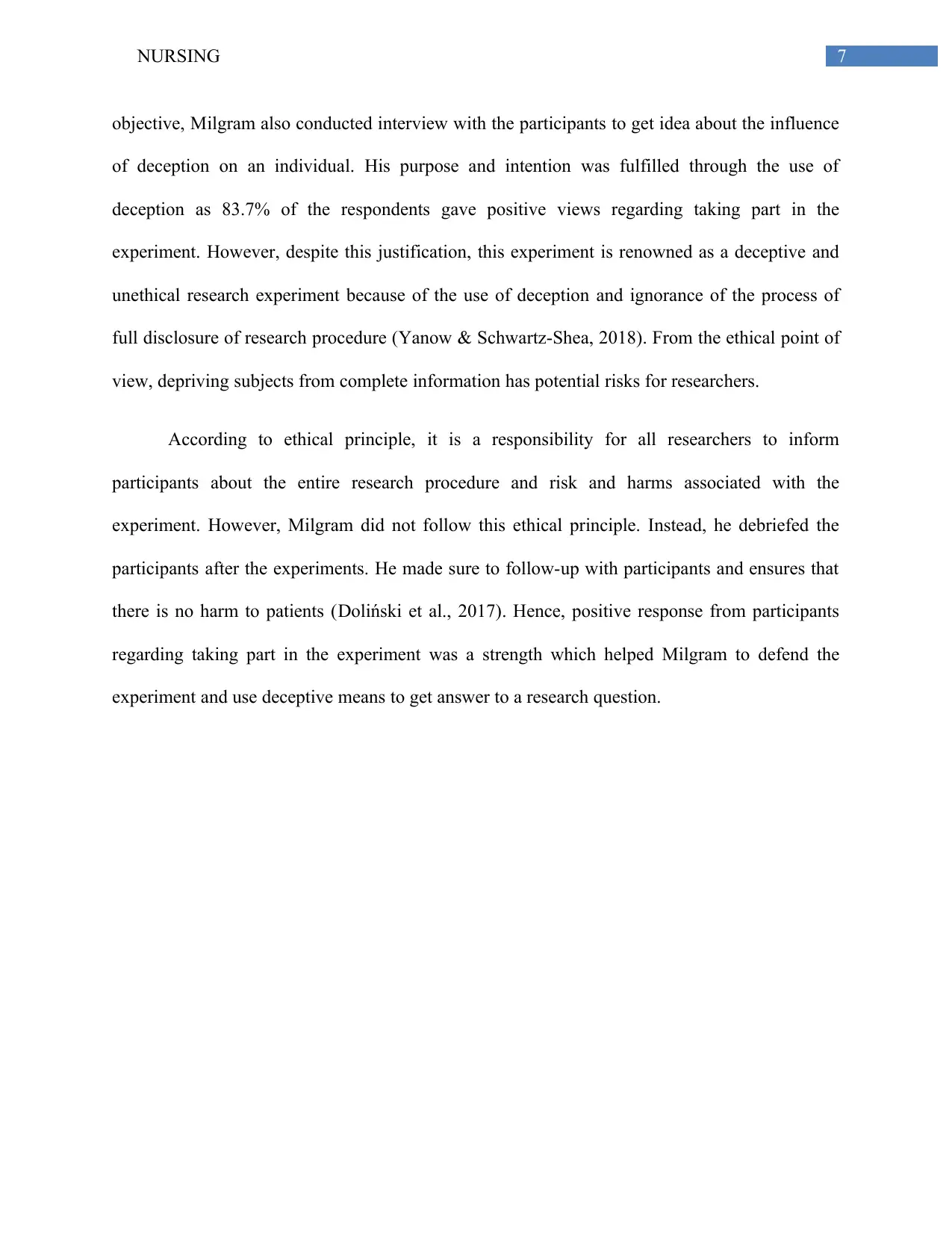
7NURSING
objective, Milgram also conducted interview with the participants to get idea about the influence
of deception on an individual. His purpose and intention was fulfilled through the use of
deception as 83.7% of the respondents gave positive views regarding taking part in the
experiment. However, despite this justification, this experiment is renowned as a deceptive and
unethical research experiment because of the use of deception and ignorance of the process of
full disclosure of research procedure (Yanow & Schwartz-Shea, 2018). From the ethical point of
view, depriving subjects from complete information has potential risks for researchers.
According to ethical principle, it is a responsibility for all researchers to inform
participants about the entire research procedure and risk and harms associated with the
experiment. However, Milgram did not follow this ethical principle. Instead, he debriefed the
participants after the experiments. He made sure to follow-up with participants and ensures that
there is no harm to patients (Doliński et al., 2017). Hence, positive response from participants
regarding taking part in the experiment was a strength which helped Milgram to defend the
experiment and use deceptive means to get answer to a research question.
objective, Milgram also conducted interview with the participants to get idea about the influence
of deception on an individual. His purpose and intention was fulfilled through the use of
deception as 83.7% of the respondents gave positive views regarding taking part in the
experiment. However, despite this justification, this experiment is renowned as a deceptive and
unethical research experiment because of the use of deception and ignorance of the process of
full disclosure of research procedure (Yanow & Schwartz-Shea, 2018). From the ethical point of
view, depriving subjects from complete information has potential risks for researchers.
According to ethical principle, it is a responsibility for all researchers to inform
participants about the entire research procedure and risk and harms associated with the
experiment. However, Milgram did not follow this ethical principle. Instead, he debriefed the
participants after the experiments. He made sure to follow-up with participants and ensures that
there is no harm to patients (Doliński et al., 2017). Hence, positive response from participants
regarding taking part in the experiment was a strength which helped Milgram to defend the
experiment and use deceptive means to get answer to a research question.
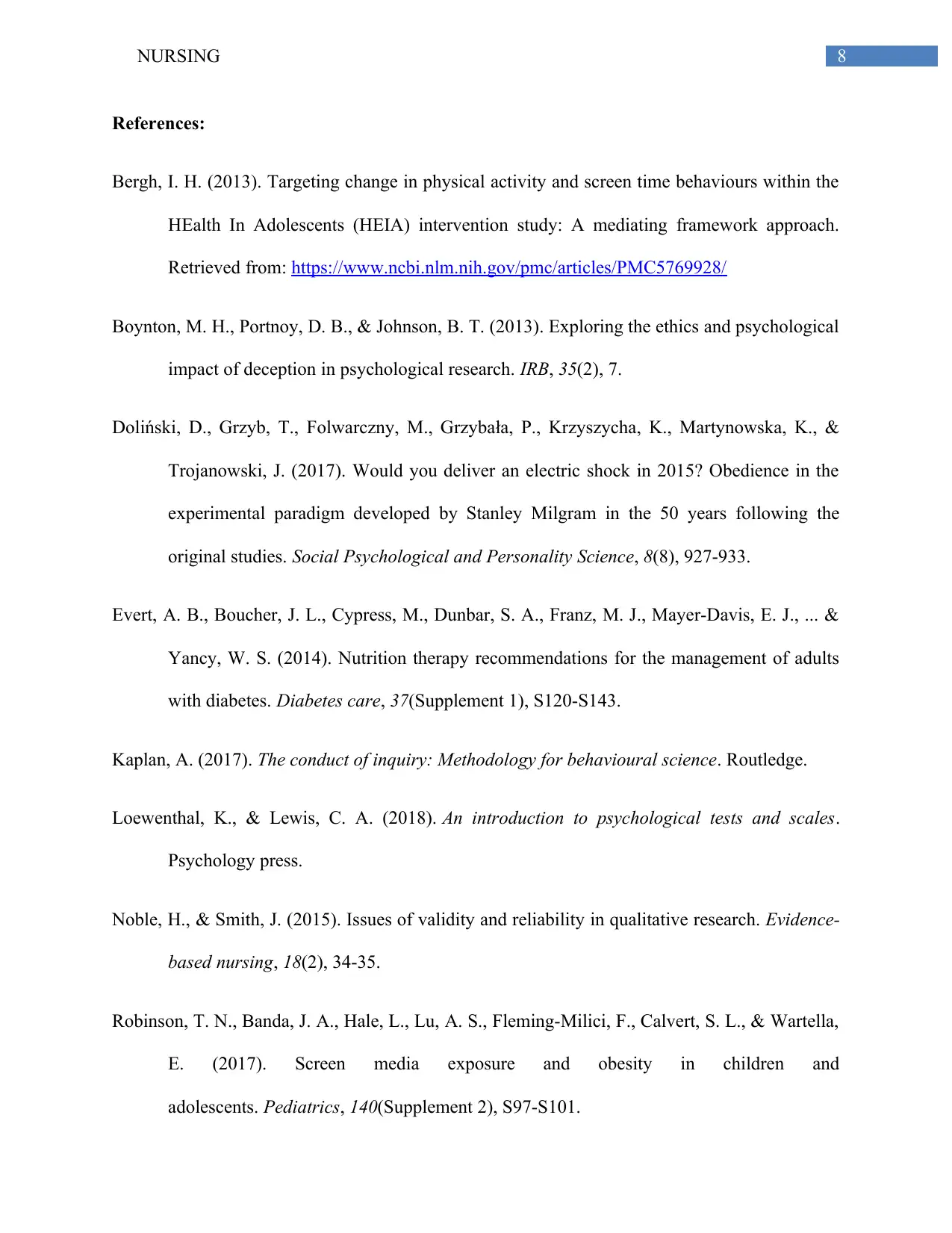
8NURSING
References:
Bergh, I. H. (2013). Targeting change in physical activity and screen time behaviours within the
HEalth In Adolescents (HEIA) intervention study: A mediating framework approach.
Retrieved from: https://www.ncbi.nlm.nih.gov/pmc/articles/PMC5769928/
Boynton, M. H., Portnoy, D. B., & Johnson, B. T. (2013). Exploring the ethics and psychological
impact of deception in psychological research. IRB, 35(2), 7.
Doliński, D., Grzyb, T., Folwarczny, M., Grzybała, P., Krzyszycha, K., Martynowska, K., &
Trojanowski, J. (2017). Would you deliver an electric shock in 2015? Obedience in the
experimental paradigm developed by Stanley Milgram in the 50 years following the
original studies. Social Psychological and Personality Science, 8(8), 927-933.
Evert, A. B., Boucher, J. L., Cypress, M., Dunbar, S. A., Franz, M. J., Mayer-Davis, E. J., ... &
Yancy, W. S. (2014). Nutrition therapy recommendations for the management of adults
with diabetes. Diabetes care, 37(Supplement 1), S120-S143.
Kaplan, A. (2017). The conduct of inquiry: Methodology for behavioural science. Routledge.
Loewenthal, K., & Lewis, C. A. (2018). An introduction to psychological tests and scales.
Psychology press.
Noble, H., & Smith, J. (2015). Issues of validity and reliability in qualitative research. Evidence-
based nursing, 18(2), 34-35.
Robinson, T. N., Banda, J. A., Hale, L., Lu, A. S., Fleming-Milici, F., Calvert, S. L., & Wartella,
E. (2017). Screen media exposure and obesity in children and
adolescents. Pediatrics, 140(Supplement 2), S97-S101.
References:
Bergh, I. H. (2013). Targeting change in physical activity and screen time behaviours within the
HEalth In Adolescents (HEIA) intervention study: A mediating framework approach.
Retrieved from: https://www.ncbi.nlm.nih.gov/pmc/articles/PMC5769928/
Boynton, M. H., Portnoy, D. B., & Johnson, B. T. (2013). Exploring the ethics and psychological
impact of deception in psychological research. IRB, 35(2), 7.
Doliński, D., Grzyb, T., Folwarczny, M., Grzybała, P., Krzyszycha, K., Martynowska, K., &
Trojanowski, J. (2017). Would you deliver an electric shock in 2015? Obedience in the
experimental paradigm developed by Stanley Milgram in the 50 years following the
original studies. Social Psychological and Personality Science, 8(8), 927-933.
Evert, A. B., Boucher, J. L., Cypress, M., Dunbar, S. A., Franz, M. J., Mayer-Davis, E. J., ... &
Yancy, W. S. (2014). Nutrition therapy recommendations for the management of adults
with diabetes. Diabetes care, 37(Supplement 1), S120-S143.
Kaplan, A. (2017). The conduct of inquiry: Methodology for behavioural science. Routledge.
Loewenthal, K., & Lewis, C. A. (2018). An introduction to psychological tests and scales.
Psychology press.
Noble, H., & Smith, J. (2015). Issues of validity and reliability in qualitative research. Evidence-
based nursing, 18(2), 34-35.
Robinson, T. N., Banda, J. A., Hale, L., Lu, A. S., Fleming-Milici, F., Calvert, S. L., & Wartella,
E. (2017). Screen media exposure and obesity in children and
adolescents. Pediatrics, 140(Supplement 2), S97-S101.
⊘ This is a preview!⊘
Do you want full access?
Subscribe today to unlock all pages.

Trusted by 1+ million students worldwide
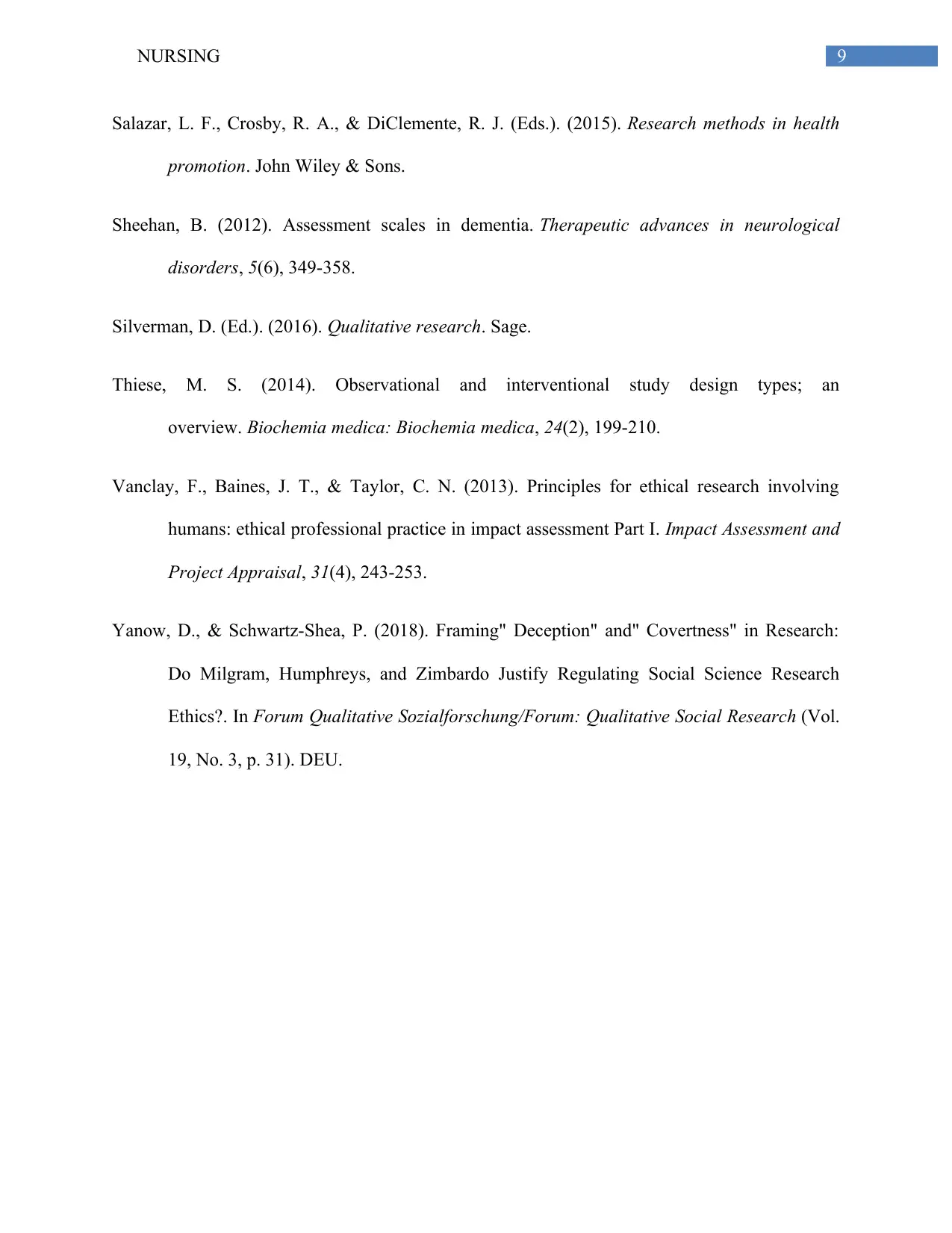
9NURSING
Salazar, L. F., Crosby, R. A., & DiClemente, R. J. (Eds.). (2015). Research methods in health
promotion. John Wiley & Sons.
Sheehan, B. (2012). Assessment scales in dementia. Therapeutic advances in neurological
disorders, 5(6), 349-358.
Silverman, D. (Ed.). (2016). Qualitative research. Sage.
Thiese, M. S. (2014). Observational and interventional study design types; an
overview. Biochemia medica: Biochemia medica, 24(2), 199-210.
Vanclay, F., Baines, J. T., & Taylor, C. N. (2013). Principles for ethical research involving
humans: ethical professional practice in impact assessment Part I. Impact Assessment and
Project Appraisal, 31(4), 243-253.
Yanow, D., & Schwartz-Shea, P. (2018). Framing" Deception" and" Covertness" in Research:
Do Milgram, Humphreys, and Zimbardo Justify Regulating Social Science Research
Ethics?. In Forum Qualitative Sozialforschung/Forum: Qualitative Social Research (Vol.
19, No. 3, p. 31). DEU.
Salazar, L. F., Crosby, R. A., & DiClemente, R. J. (Eds.). (2015). Research methods in health
promotion. John Wiley & Sons.
Sheehan, B. (2012). Assessment scales in dementia. Therapeutic advances in neurological
disorders, 5(6), 349-358.
Silverman, D. (Ed.). (2016). Qualitative research. Sage.
Thiese, M. S. (2014). Observational and interventional study design types; an
overview. Biochemia medica: Biochemia medica, 24(2), 199-210.
Vanclay, F., Baines, J. T., & Taylor, C. N. (2013). Principles for ethical research involving
humans: ethical professional practice in impact assessment Part I. Impact Assessment and
Project Appraisal, 31(4), 243-253.
Yanow, D., & Schwartz-Shea, P. (2018). Framing" Deception" and" Covertness" in Research:
Do Milgram, Humphreys, and Zimbardo Justify Regulating Social Science Research
Ethics?. In Forum Qualitative Sozialforschung/Forum: Qualitative Social Research (Vol.
19, No. 3, p. 31). DEU.
1 out of 10
Related Documents
Your All-in-One AI-Powered Toolkit for Academic Success.
+13062052269
info@desklib.com
Available 24*7 on WhatsApp / Email
![[object Object]](/_next/static/media/star-bottom.7253800d.svg)
Unlock your academic potential
Copyright © 2020–2025 A2Z Services. All Rights Reserved. Developed and managed by ZUCOL.





